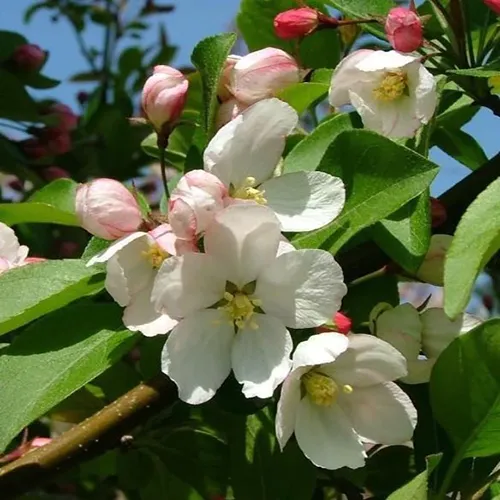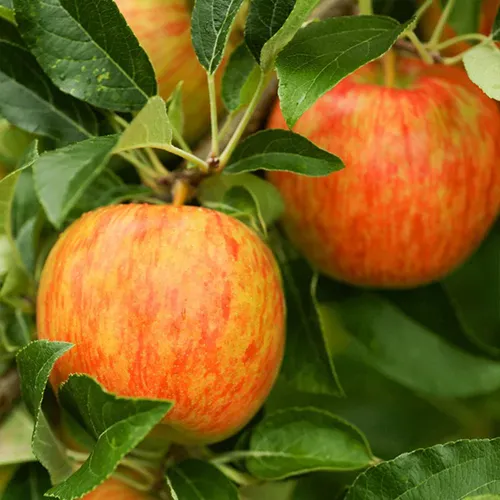If there’s a more eye-catching bonsai than an apple tree in fruit, I don’t know what it is. The contrast in scale between the full-sized fruits on the tiny tree is pretty striking.
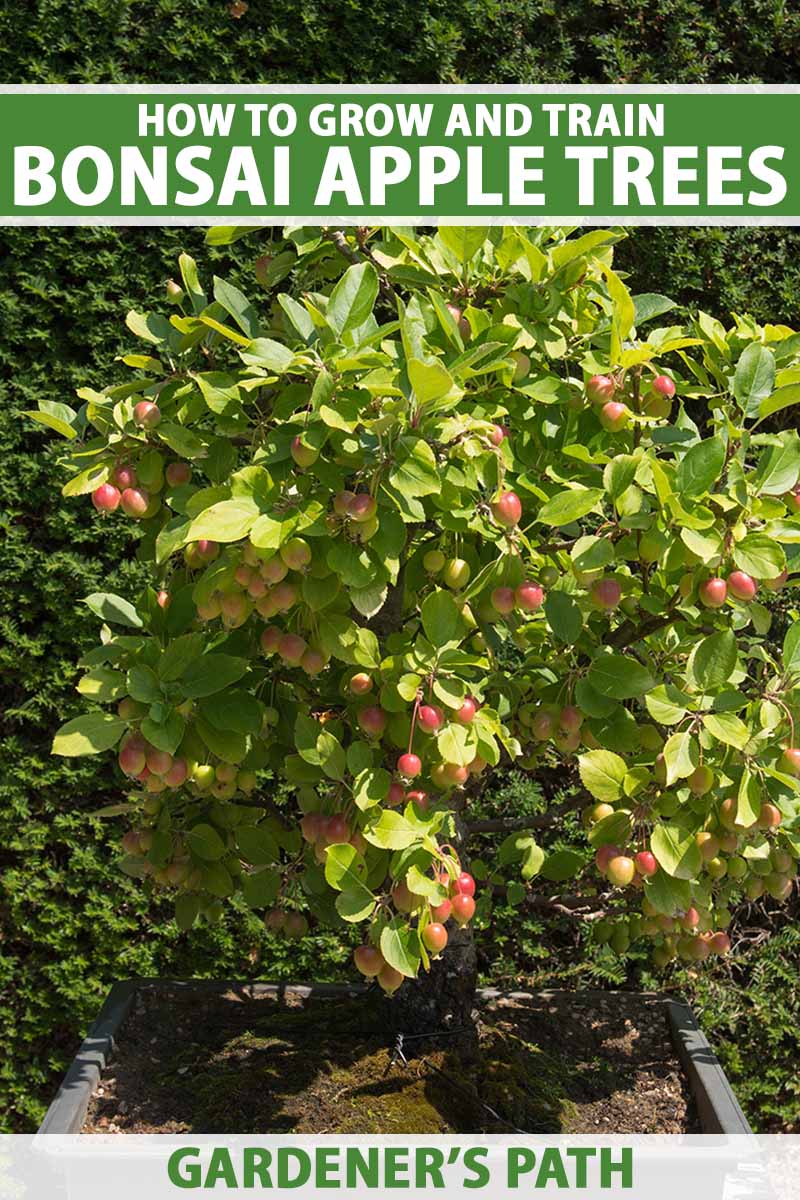
We link to vendors to help you find relevant products. If you buy from one of our links, we may earn a commission.
It’s not just about the fruit, though. Apples are moderately quick-growing hardwood trees, which means you can make them into an elegant, dramatic piece of visual art within your lifetime.
Apple trees have attractive foliage and bark, which lends them all the more to creating a distinctive display.
This isn’t a beginner’s project, necessarily. It helps if you have some experience.
But anyone can grow full-sized fruits on their miniature specimen. We’ll help you along the way with the following information:
What You’ll Learn
Before we get completely immersed in the joy of raising these special trees, you want to make sure you understand the basics.
If this is your first bonsai, check out our guide so you’ll be set up for success.
Now, I’m not saying that you shouldn’t start with apples, but just be aware that Malus domestica isn’t one of the easiest species to work with.
Crabapples can be a bit more forgiving, and we’ll discuss those below as well.
If you’re already familiar with the art form and want to take things to the next level with something dramatic, then let’s dive straight in.
Soil
The foundation of all good bonsai starts with the soil.
Think of the soil as a living extension of the tree rather than as an inert substance that merely keeps the plant in place.

Good soil contains beneficial microorganisms and lots of organic matter that is essential to the health of the tree.
It also allows air to reach the roots and holds enough water that the tree can thrive, but not so much that the roots are smothered.
We have a guide to walk you through making the perfect bonsai soil, but if you’re just starting out, it’s perfectly fine to just buy a premade medium like this one from Amazon.

I’ve used this product, made out of lava rock, limestone pea rock, calcined clay, and pine bark, with great success. It comes in 2.2- or 8.2-quart bags.
Potting Up
Genetically, the apple tree (Malus spp.) that you might choose to grow as bonsai is the exact same type of plant as one you might grow in the ground.
These aren’t dwarf specimens, and the fruits that they produce are the same in size as the ones you’d pull off a tree in an orchard.
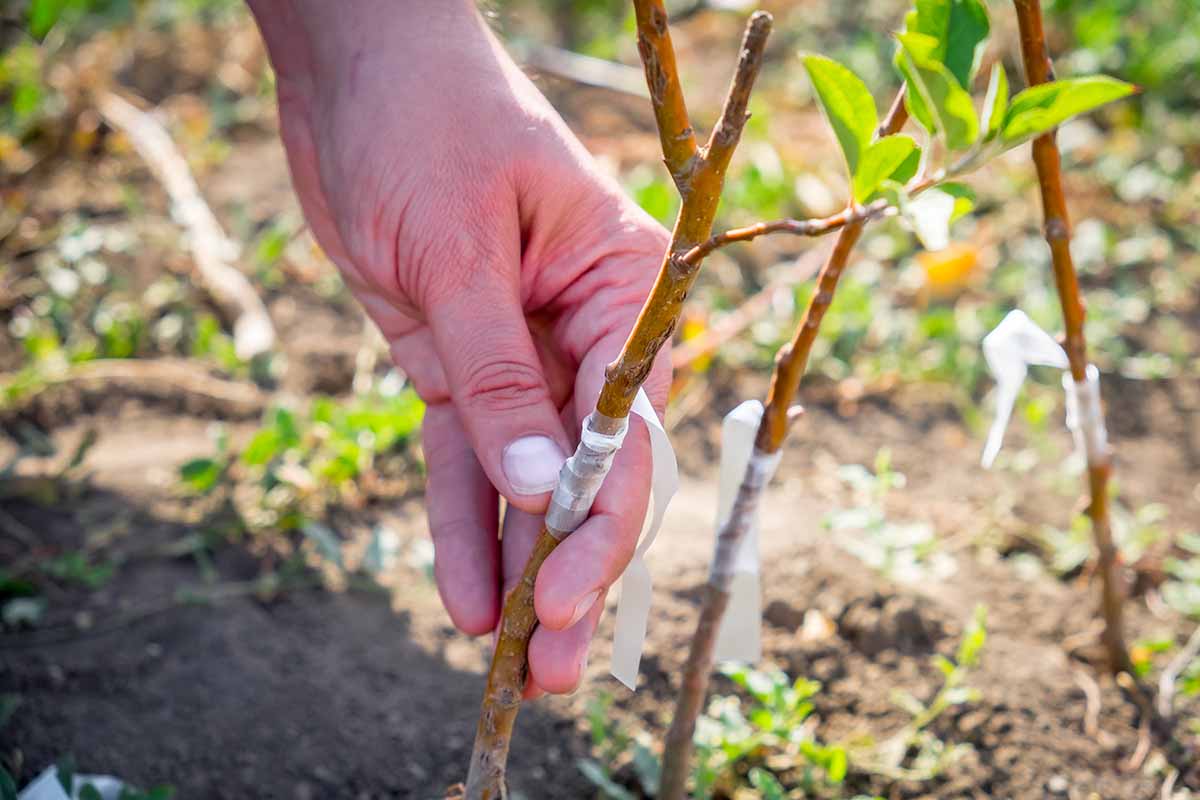
To begin with, you need to obtain a sapling. You can buy one, but it can sometimes be a challenge to find ones that are small enough.
Most nurseries sell trees that are already several feet tall, which is too big.
If you let your local nursery know that you’re looking for a small tree, sometimes they can set one aside that isn’t up to their usual sizing standards for retail sale.
You can also take cuttings, start from seed, or dig up a wild seedling. Just keep in mind that if you start a tree from seed, it might not grow true with all the same characteristics as the parent plant.
To pot it for bonsai, you don’t want to do a ton of pruning initially. Focus on the roots instead, and trim them down to fit inside the desired container.
As a general rule of thumb, the container should be about half of the tree’s height on its widest side. To figure out what size you need, divide the tree’s height in inches by half. That’s the pot dimension on the longest size that you should look for.
If you end up trimming a lot of roots, you’ll need to trim the branches a bit so the roots that are left in place can support the canopy. There’s no hard and fast rule here, but if you trim half of the roots, trim about a quarter of the canopy.
Anchor the tree if necessary, and fill in around the plant with a bonsai potting medium.
Watering and Fertilizing
Always water your bonsai at the soil level, and avoid sprinkling the branches or foliage.
You should allow the soil to become nearly completely dry, but water it before the medium is completely dried out.

Don’t rely on a routine or set a regular watering schedule. Instead, you may want to set a schedule to check the soil moisture, if it helps you to remember to water as needed.
Touch the soil or lift the plant and test the weight of the pot. Heavier pots contain more moisture.
All bonsai trees need fertilizer as well. They’re growing in a tiny pot and can’t send out roots to find nutrients when they run low. But fruit trees need even more food than other species because they use more nutrients to make those big ol’ fruits.
Instead of providing more fertilizer all at once, feed plants more frequently.
Any fertilizer you use needs to have nitrogen, phosphorus, and potassium – or NPK – along with boron, zinc, sulfur, chlorine, and magnesium.
You can use liquid fertilizers, but controlled-release ones will make your life so much easier. Look for something formulated for use on fruit trees, or go with a bonsai-specific fertilizer.
Bonsai Boy sells a slow-release fertilizer in four-ounce packs that works like a charm.
Winter Care
Contrary to popular belief, you can’t bring a fruiting bonsai indoors during the winter.
These are deciduous trees that need to experience the changing seasons to survive.
Apples, in particular, need at least 500 “chilling hours” below 45°F to bear fruit, possibly closer to 1000 hours depending on the cultivar.
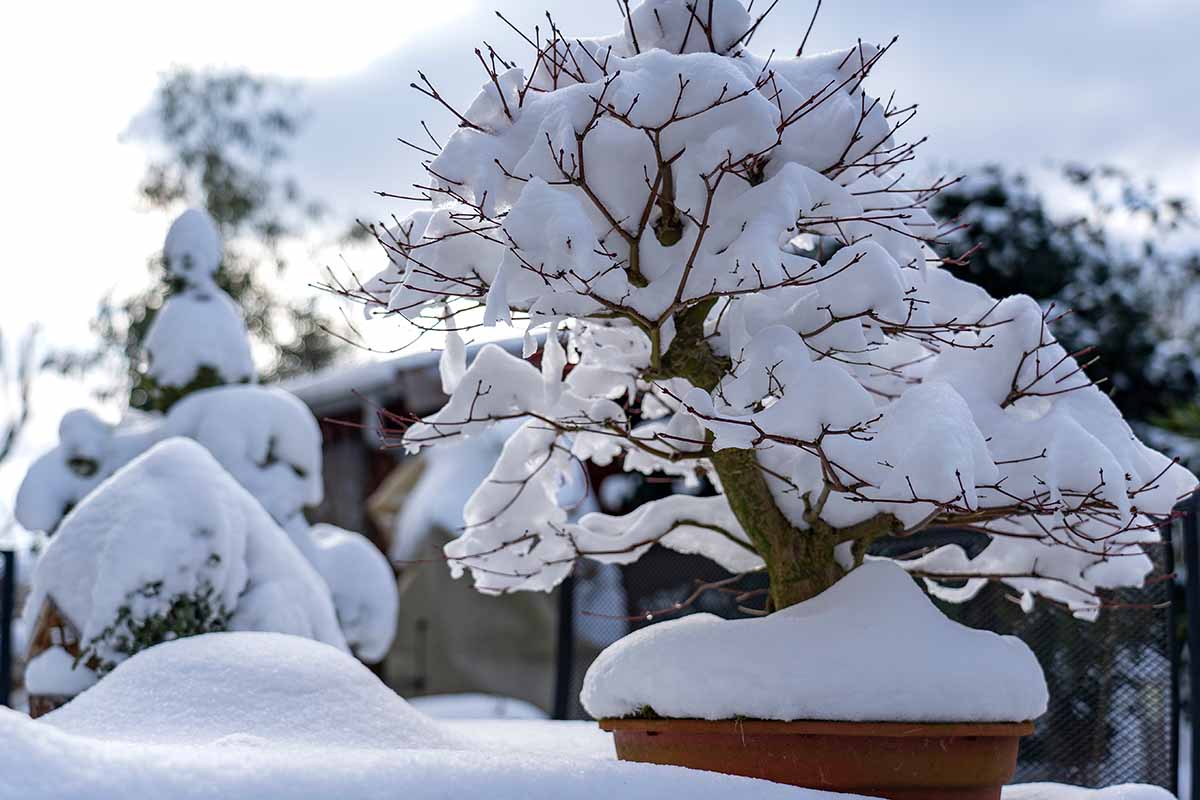
Having said that, freezing and thawing repeatedly can harm or even kill your tree. And plants growing in containers have less protection from the cold than those grown in the ground.
If you live somewhere that is particularly cold during the winter, you’ll need to provide a little protection.
Those in USDA Hardiness Zones 6 and below should place their bonsai in a cold frame or unheated greenhouse, or bring it into an unheated garage or shed for the duration of any long, deep freezes below 28°F.
Wrap the container in wool or burlap for extra protection. Do not cover the plant.
Decide on a Shape
Shaping is an entire topic in and of itself, and bonsai practitioners spend decades learning the skills of shaping their trees.
We have a guide that will help you with the overall practice of pruning that’s worth a look if you aren’t familiar with the basics.

When it comes to fruit trees, you generally want to recreate the shape that the tree would take in nature.
The goal of bonsai isn’t to create a plant that looks completely forced, but to capture a beautiful natural tableau in miniature.
In other words, don’t try to create a dramatically cascading apple bonsai. You wouldn’t ever see that shape in nature.
That doesn’t mean you need to create a generic upright shape, however. There is lots of latitude within the range of upright shapes available to you.
You could go with something windswept, known as fukinagashi, or something with a bit of movement to it, like the moyogi or shakan styles.
By the way, if you aren’t familiar with these terms, our intro to bonsai for beginners explains it all.
To shape a young specimen, you’ll want to work slowly. Only remove a few branches each year in your attempt to create the shape you want. Bonsai isn’t an artform for the impatient gardener.
How to Prune
Apples can’t tolerate a ton of pruning all at once and they should be pruned during the winter.
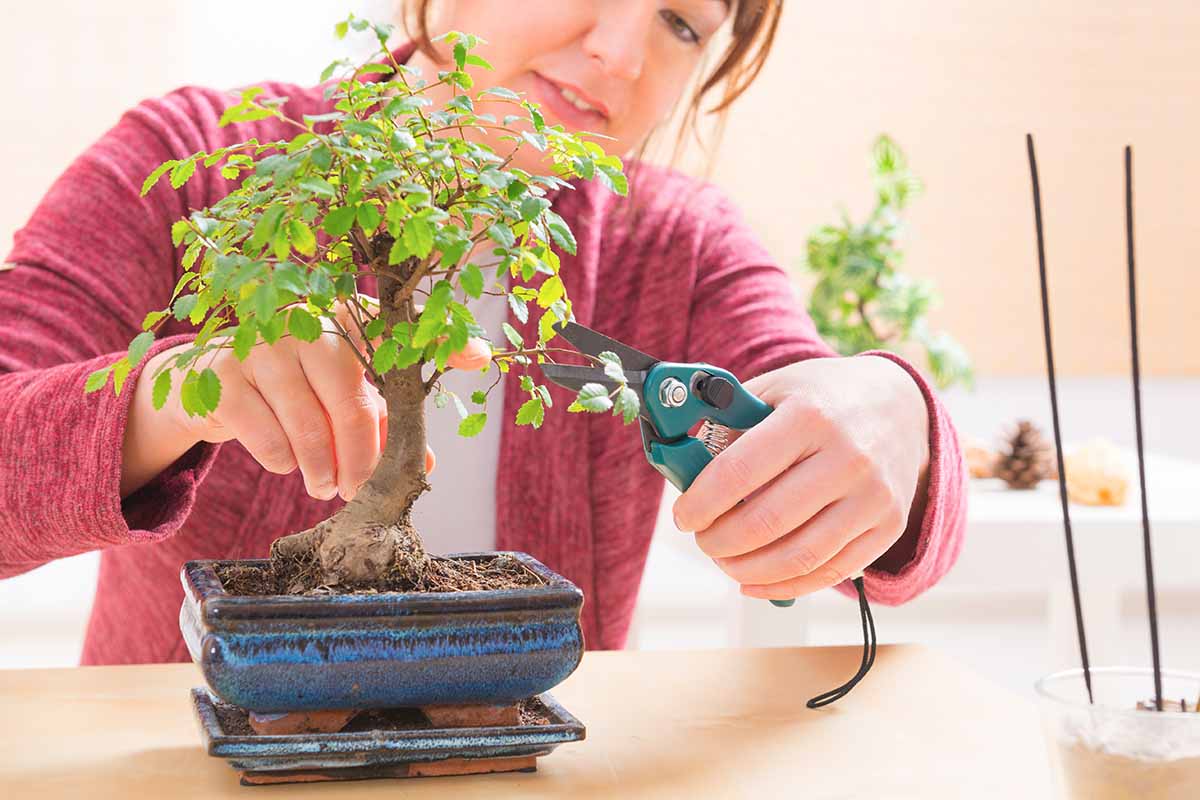
Fruit trees produce new growth in the spring, using stored energy from the previous year.
By summer, the tree has used up those stores and is feeding itself via photosynthesis, and taking up nutrients in the soil through its roots.
In the fall, the tree stores up energy to conserve through the winter and use next spring after it emerges from dormancy.
A little snip here and there won’t hurt, but if you prune heavily during any of these seasons, you limit the tree’s ability to grow well and thus produce fruit.
Heavy pruning during the winter is best. But you can also prune to remove new growth in other seasons, as needed.
This should be done in the late spring or early summer, in June or July, before any blossoms form. But again, we’re talking about just snipping off a few small emerging branches.
Heavy pruning, especially in combination with too much fertilizer, promotes leafy growth at the expense of fruit. And the biggest and most abundant fruit develops on wood that is two to five years old.
Beyond the general instructions provided in our guide to bonsai pruning, there are a few things specific to Malus species that you need to keep in mind.
To promote fruit growth, you want to create a fairly open canopy with no crossing or fully upright branches.
Depending on the size of the fruit, your tree might only be able to support one apple per branch, so keep this in mind when pruning. You want to leave enough space so the apples can develop fully.
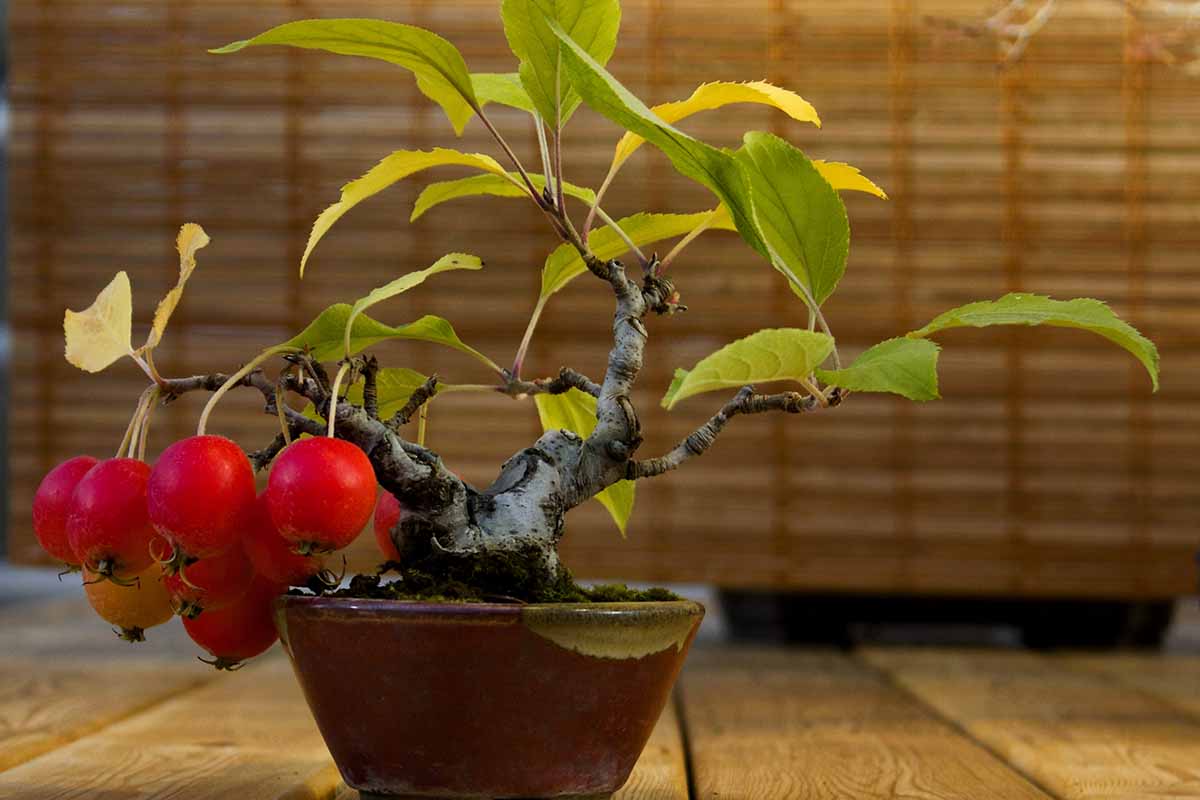
You should also pinch off excess developing fruit to avoid overwhelming your tree.
Ideally, you’ll have no more than five fruits per tree – with odd numbers being the most aesthetically pleasing – and the fruits will appear on alternating branches.
You don’t want two fruits to grow right next to each other on one side without any to balance those out on the other side.
Repotting
When it comes time to repot, do the work in late winter or early spring before the leaf buds have opened. Depending on where you live, this is usually sometime around March.

Repotting needs to be done every few years, not necessarily to increase the size of the pot, but to refresh the soil.
To do this, remove the plant from its pot and gently brush away as much of the potting medium as you can. Prune the roots to remove anything that is dead or damaged.
Remove additional roots to keep the plant constrained enough to fit in the container you’re using, whether that’s a slightly larger one or the same one the plant has been growing in.
Try to keep young roots intact while removing older ones. Don’t remove more than half of the roots all at once.
Place the plant in the container and fill in around it with fresh medium.
Cultivars to Select
This process works for all Malus species, whether you go with a big ol’ ‘Fuji’ or a tiny crabapple, so if you find a tiny saplings at a nursery and you can’t resist, go for it!
By the way, don’t confuse this plant with balsam or pitch apples. Clusia rosea is a sub-tropical tree from the Caribbean, particularly Cuba and Puerto Rico, as well as tropical South America, and Florida.
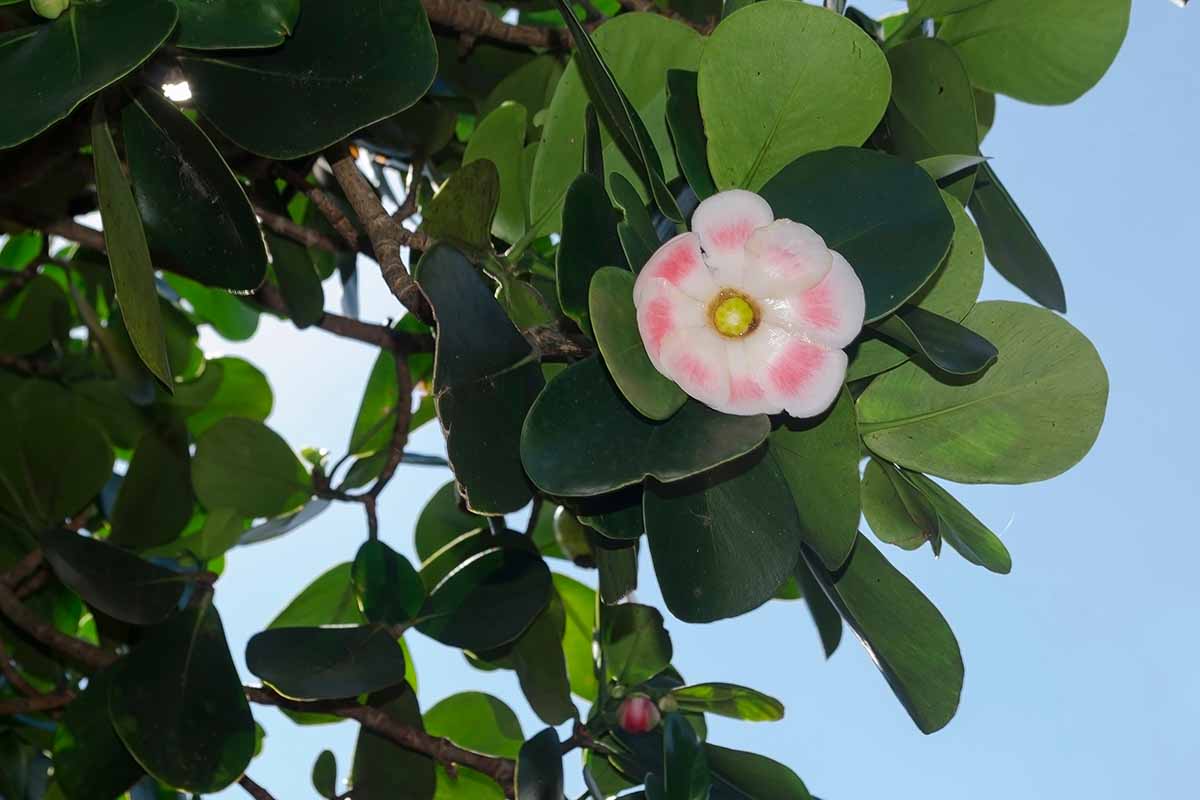
This epiphyte can make an interesting houseplant and a great bonsai for beginners, but it won’t produce those fantastic fruits. It does feature a lovely large, pink, waxy flower.
Crabapples are the most common for growing bonsai, probably because they’re faster growing and tougher, and produce fruit of a size that looks more proportional to the tree.
I actually think crabapples are some of the best options for beginners, not just to fruit tree bonsai, but to the whole art form altogether. If you’re nervous about this endeavor, start with a crabapple and go from there.
Some of the most beautiful apple tree bonsai specimens have been created using collected material collected from wild trees.
When the descendents of early New England settlers left for the Midwest in the mid-to-late 1800s, many of them left behind orchards that simply had to fend for themselves.
These trees sent out saplings that didn’t benefit from maintenance, and so many of these saplings are naturally dwarfed or smaller than the original trees in order to survive the tougher conditions.
Many of these were further interrupted by browsing by deer and rabbits, which created unusual growth in the form of dramatic shapes.
Bonsai artists have dug up some of these unusual trees and shaped them into something truly special.
Even if you don’t live in New England, keep an eye out if there are any abandoned or unmaintained orchards around you. With the land owner’s permission, of course, you might find some exceptional specimens for training.
Finally, keep in mind when you’re on the lookout for varieties to select that not all apples are self-pollinating.
That means you’ll need to have multiple cultivars around if you want fruits. Otherwise, you’ll need to pick a self-fruitful one.
If there are other apple trees in your yard or on a neighbor’s property, that’s close enough to ensure your bonsai are pollinated.
The following are excellent options because they lend themselves well to container growing and they put on a showy display.
Harvest Gold
Harvest Gold aka ‘Hargozam’ is an incredibly tough crabapple. It’s resistant to fungal diseases and pests and grows in a range of climates, from Zones 3b to 8b.

It’s covered with a blanket of white blossoms in the spring and golden yellow apples in the fall.
It’s also self-fertile, so you don’t have to worry about keeping a friend around.
Though the trees they sell are a bit too tall, you could certainly buy a Harvest Gold crabapple at Planting Tree and use it to propagate your start.
Honeycrisp
Popular in grocery stores and just as impressive as a bonsai, Honeycrisp™ apple trees are naturally compact and short, so they’re easier to keep as a bonsai.
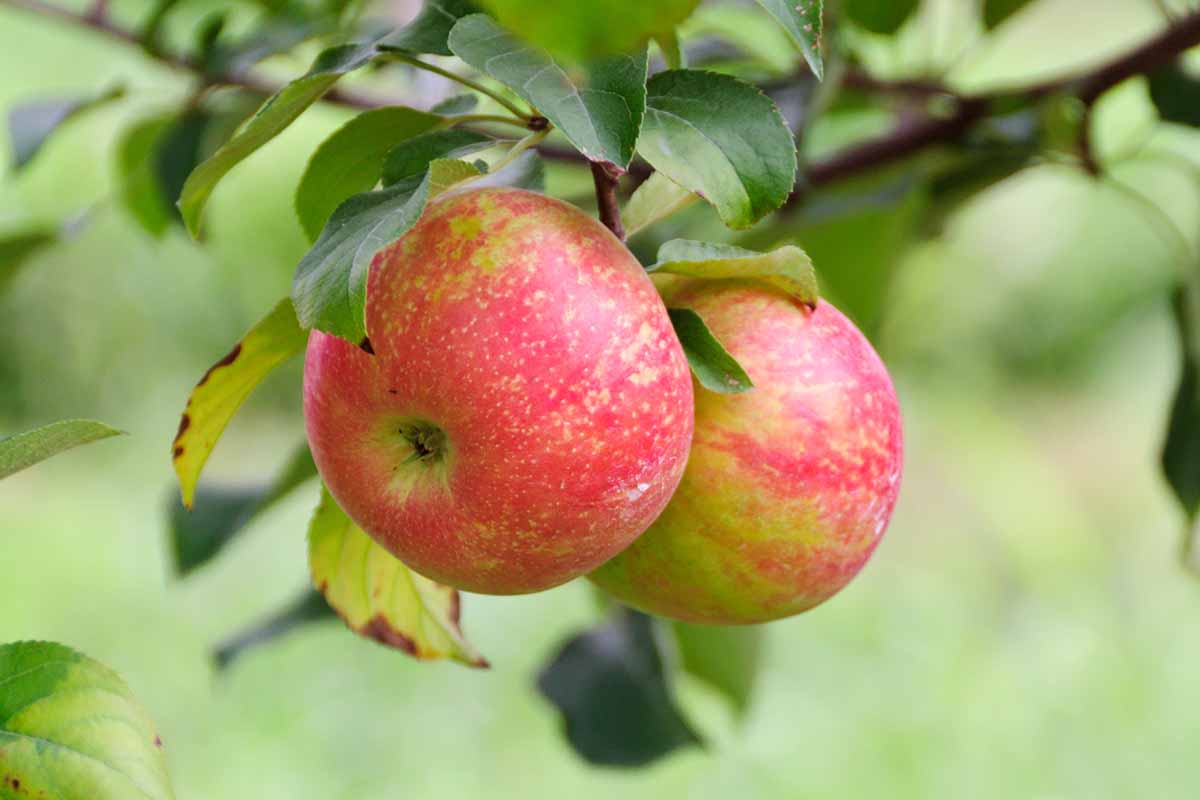
The glossy red fruit has streaks of yellow, which makes for a splashy show.
It can adapt to growing in Zones 3 through 7, but Honeycrisp does best in Zones 3 and 4.
Honeycrisp isn’t self-fertile, but it’s so nice that it’s worth keeping a ‘Fuji,’ ‘Red Delicious,’ or ‘Golden Delicious’ around for fertilization.
Pick up a four to five, five to six, or six to seven foot tall tree at Fast Growing Trees and use it to take cuttings for your new bonsai.
Learn more about Honeycrisp cultivars here.
Jonathan
Self-fertile with medium-sized, bright red and yellow fruits, ‘Jonathan’ is a looker. The skin of this Northeast heirloom is smooth and glossy, and the apples have that picture-perfect shape.
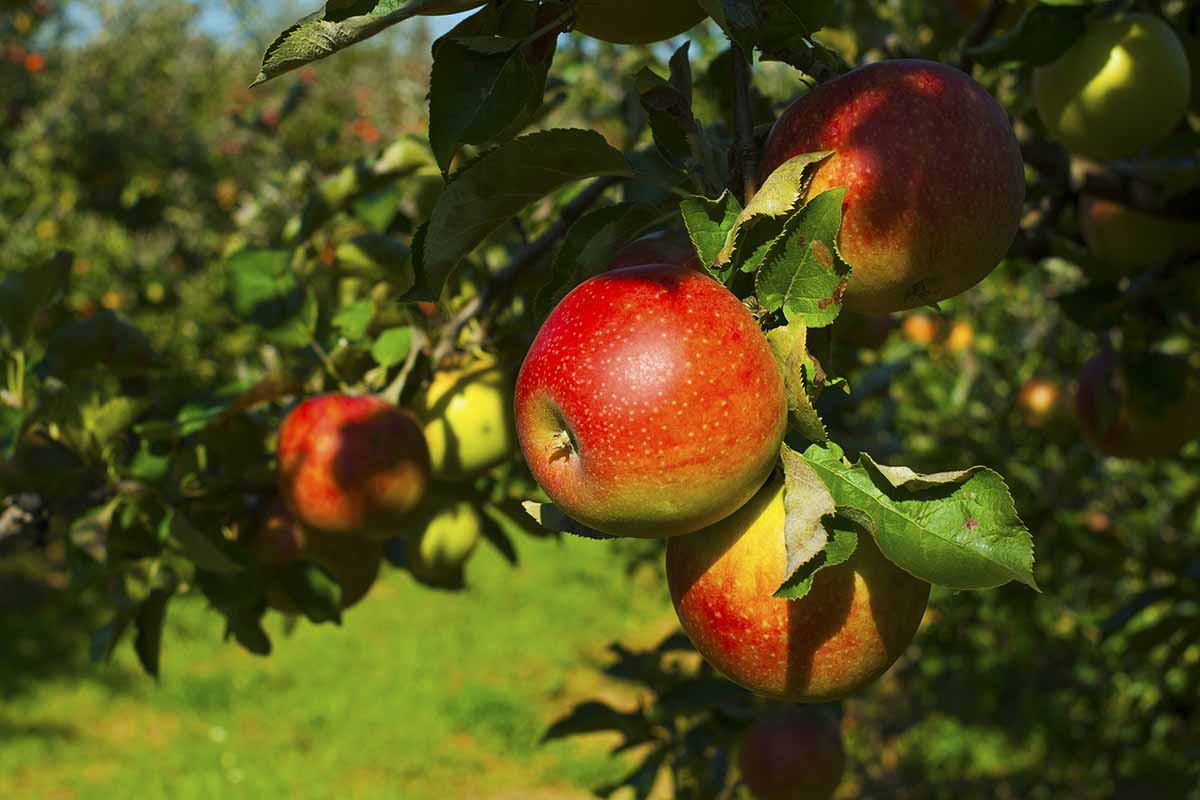
Not that the flavor is the point in bonsai, but this cultivar is often rated as one of the tastiest. It’s hardy in Zones 4 through 8.
Managing Pests and Disease
Anything that attacks Malus trees in an orchard can attack ones that are growing in a pot as well.
On the bright side, you’ll be able to see any pest or disease problems much more easily on your bonsai than on, say, a tree tucked back into the far corner of a large orchard.
Deer and rabbits will go for these trees, but if you keep them on a display table or shelf, or behind a fence and near your home, it’s unlikely that they’ll cause a problem.
When it comes to diseases, sooty blotch and flyspeck are common issues in some areas. Our guide explains this disease and how to deal with it more fully.
You should also watch out for fire blight, powdery mildew, rust, root rot, and white rot.
We have a guide to apple diseases that describes more about each of these and how to address them.
You’d deal with any of these diseases on bonsai the same way you would on a full-size tree planted in the ground, just on a much tinier scale!
Speaking of scale…
Scale insects are tiny sapsuckers that feed on the bark and fruits of several fruit species, causing them to become weak.
While a full-sized tree can withstand an oyster shell (Lepidosaphes ulmi) or San Jose scale (Quadraspidiotus perniciosus) infestation, a small bonsai will rapidly deteriorate.
Luckily, dealing with these pests is easy. Just scrub them off with a soapy toothbrush.
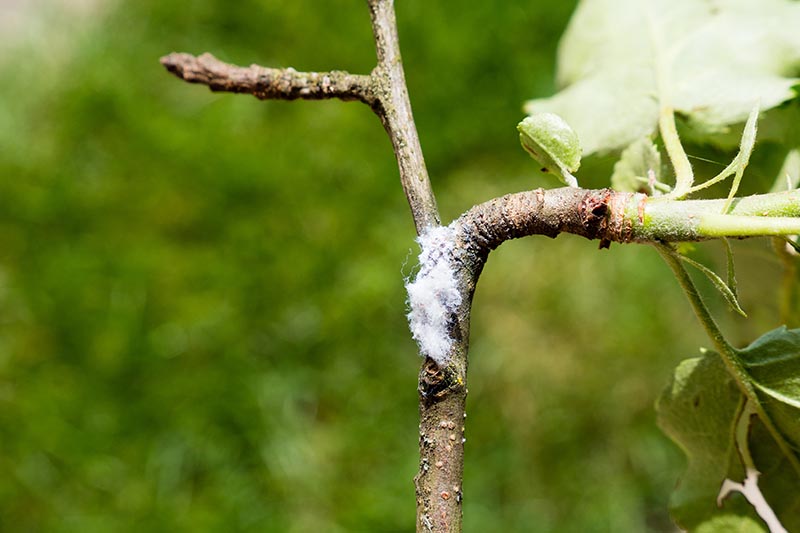
Wooly aphids (Eriosoma lanigerum) are also a common pest on apples that may cause damage. Read our guide to learn more.
How Soon Can I Expect Fruit?
The short answer is, about 10 years from sowing seed.
If you bought your plant as a sapling, you can assume it is a year or two old – so within eight or nine years, you should expect fruit.
And bonsai apples will produce fruit at the same time of year as trees in the ground: generally in autumn, sometimes earlier depending on the cultivar.

Growing bonsai isn’t the same as growing a tree in the ground. You will usually see fruit on apple trees in normal conditions within five years after planting.
That’s because you typically start with larger plants, and because trees planted in the ground experience less stress than those being trained as bonsai in pots.
Your bonsai tree could potentially start producing fruit within this timeframe, but because you’re growing it under more stressful conditions in a small container with constrained roots, it will likely take longer.
Don’t get too hung up on the timeframe. Bonsai is an art and as such, you can’t rush it.
Your plant will produce on its own time. Some might never produce, and you’ll just have to enjoy these for the shape and foliage. That’s no challenge!
This Special Bonsai Will Be the Apple of Your Eye
I remember the first time I saw an apple bonsai in full fruit. I am absolutely sure I looked like a cartoon character doing a bug-eyed triple-take. I wish I could have seen my face.
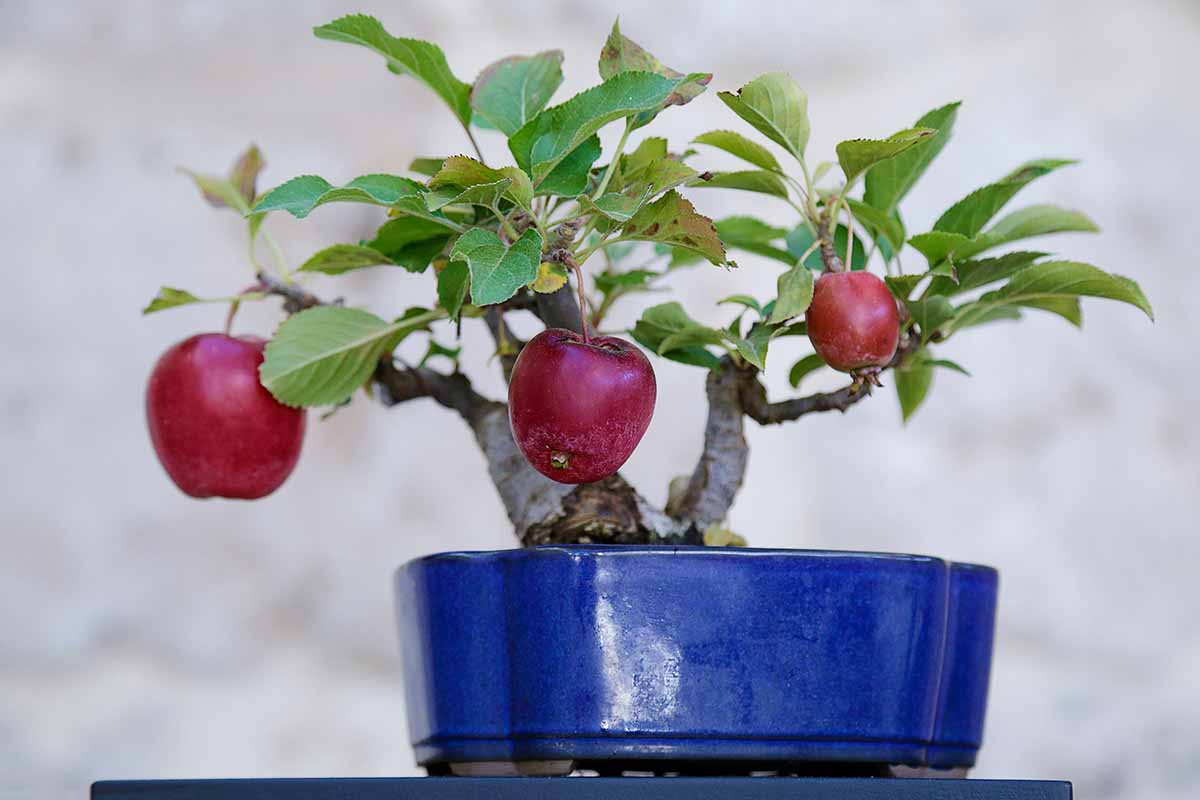
Bonsai isn’t a showy, loud art form; it’s subtle and elegant. But if there’s a standout always looking to grab attention, it’s these trees. They’re just so dramatic and eye-catching.
Honestly, just talking about these works of art makes me feel excited to see what you’ll come up with. Share pictures and details about your particular specimen with all of us in the comments section below.
I truly hope this guide helped you start your journey with these striking plants. If you have a hankering to try your hand at some other bonsai trees, check out these articles next:

